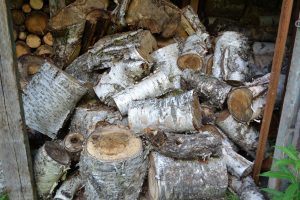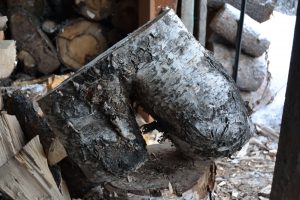I’ve been taking advantage of our cold weather to split the most ugly, cantankerous, gnarly, and twisted pieces of wood that you can imagine.
Boy, have there been some tough ones. I wrote about the glory of winning in battle over these mean, twisted, miserable chunks of firewood last winter. It’s still one of the truly wonderful parts of our -30 to -40 F cold snaps. The added brittleness of the wood usually makes these stubborn pieces of firewood split fairly easily.
But this year I have one tree that is just killing me. Every damned piece of this thing has been a fight.
Son of a Birch!
Regular readers may remember when I found an old birch on the hill behind the house that had a visible fire scar at its base. I cored that tree and found that it had been growing for 120-130 years since that fire.
I may not have mentioned that about a year later it was clear that this venerable old tree was dying fast, so I cut it down and diced it up for firewood. Wow, was that a big tree. And seriously heavy. I carried it piece by piece out of a thicket and stacked it in the woods to dry for two years. The basal pieces were too big and heavy to lift, even after drying for a year, so I had to take the saw back out there and cut them in half. This past summer I hauled the whole thing out manually piece by piece and stacked it in the woodshed for burning this winter. It was a massive effort and most of a cord.
We burn a mix of aspen, spruce, and birch, and this year I had the sense to stack this blend in roughly sorted groups so I could draw from the most appropriate wood for the weather. Aspen burns fast and hot and is perfect for warming the house quickly in the evenings; and in moderate weather the house holds enough heat overnight that you want the fire to go out. Spruce puts out a nice heat with a longer finish, which is great for cooler nights. And birch is what you want to pack the firebox with overnight when it’s really cold out. So I’ve been splitting a lot of birch lately. And most of it happens to be from that gnarly old tree.
It’s been just one twisted chunk of misery after another. The tree had been about ten inches in diameter when the fire damaged it, so it was easily over 200 years old. After wrestling with that miserable old thing for so long, I am pretty sure that every grain that was laid down for the past 120-130 years was optimally placed to foil this puny human.
There are two odd things about this tree. First, there were so many ugly chunks that I overloaded the Quasimodo pile and had to stack a lot of the tough-looking pieces in among the more normal ones. The other odd thing is that even the normal-looking pieces have proven to be uncommonly hard to split. What would ordinarily take one or maybe two whacks with the splitting maul will take 3 to 6—and really hard ones. Gut-grunting, muscle-pulling, all-out, full-tilt, hard-as-I-can-swing strokes. And the eight-pound head of the splitting maul goes in about half an inch and the log just gives a little squeak—mocking my tiny muscles.
One piece I just could not get to split. That’s never happened before. It seemed small enough that I could get it into the stove, so I hauled it inside whole—and it was just too big to fit in the stove door that night. Foiled again. Ten degrees colder and another 10-15 strokes and I solved that problem. Overconfidence regained, I took on another challenging piece and hit the proverbial brick wall. I stopped counting after 20 hits but had the good sense to stop before 30. Inspiration struck. The day before, I’d decimated my chopping block and needed a new one. This seemed like a well-tested volunteer, and it’s been working great for the past week.
I have to say, that once it’s split into stove-sized pieces, this old birch burns like a long, warm dream. So despite all my complaining, my hat is off to my nemesis tree. Perhaps I’ll grow up to be an ugly twisted bastard someday, too.


